Social Work Report: Inter-Religion Organization Challenges and Changes
VerifiedAdded on 2020/03/16
|13
|2864
|39
Report
AI Summary
This report provides an analysis of the Inter-Religion Organization (IRO), focusing on the responsibilities of its managers, the key challenges they face, and the extent to which these challenges are attributed to the unique characteristics of social service organizations. The report highlights the communication barriers and performance evaluation difficulties faced by managers, especially in a multicultural environment. It examines the significant changes implemented in the organization over the past five years, such as the adoption of multilingual flexibility and technological advancements, and their effects on both the internal and external environments. A critical evaluation of the organizational structure, including its hierarchical structure and key elements like work specialization and departmentalization, is also included, along with the impact of multiculturalism and technological integration on the organization's performance and sustainability.
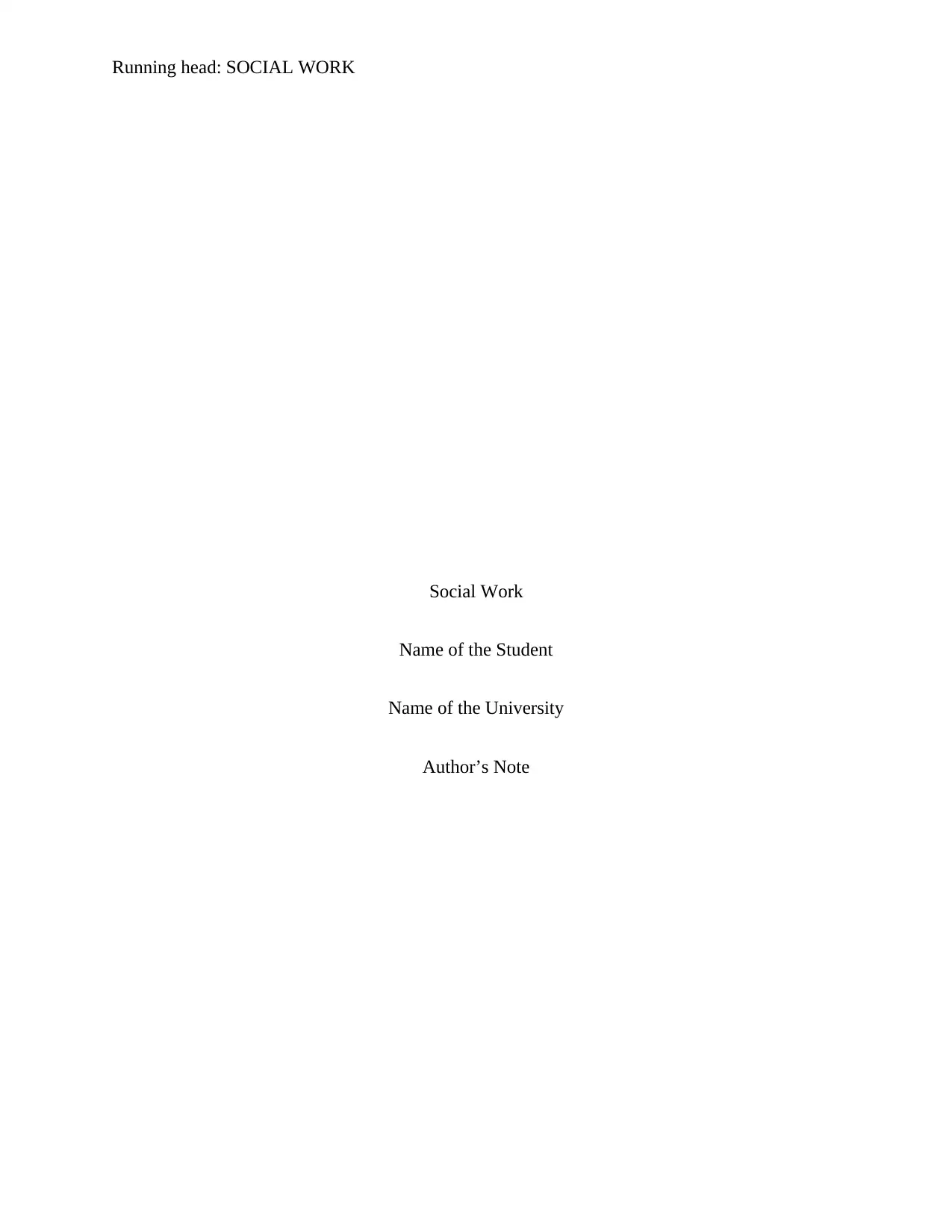
Running head: SOCIAL WORK
Social Work
Name of the Student
Name of the University
Author’s Note
Social Work
Name of the Student
Name of the University
Author’s Note
Paraphrase This Document
Need a fresh take? Get an instant paraphrase of this document with our AI Paraphraser
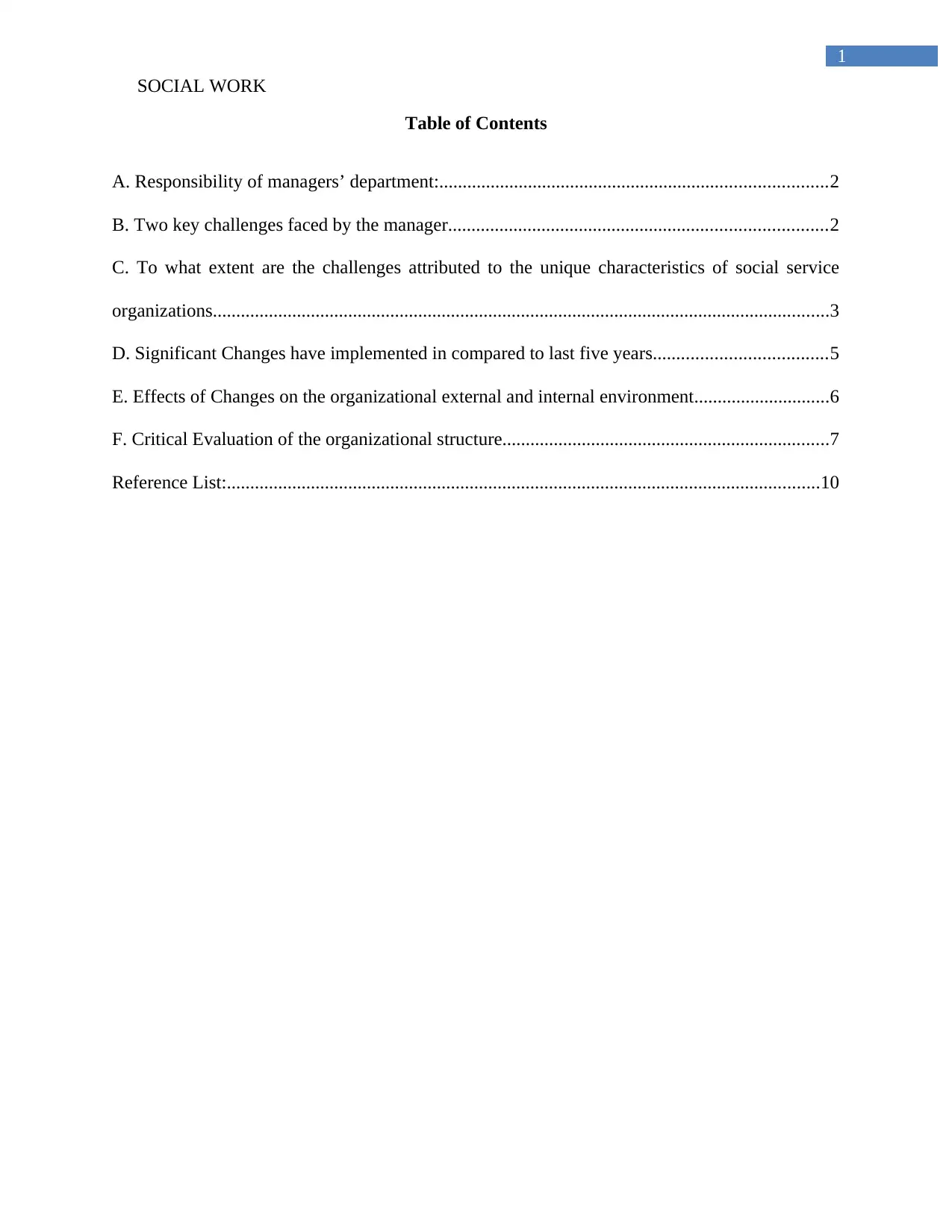
1
SOCIAL WORK
Table of Contents
A. Responsibility of managers’ department:...................................................................................2
B. Two key challenges faced by the manager.................................................................................2
C. To what extent are the challenges attributed to the unique characteristics of social service
organizations....................................................................................................................................3
D. Significant Changes have implemented in compared to last five years.....................................5
E. Effects of Changes on the organizational external and internal environment.............................6
F. Critical Evaluation of the organizational structure......................................................................7
Reference List:...............................................................................................................................10
SOCIAL WORK
Table of Contents
A. Responsibility of managers’ department:...................................................................................2
B. Two key challenges faced by the manager.................................................................................2
C. To what extent are the challenges attributed to the unique characteristics of social service
organizations....................................................................................................................................3
D. Significant Changes have implemented in compared to last five years.....................................5
E. Effects of Changes on the organizational external and internal environment.............................6
F. Critical Evaluation of the organizational structure......................................................................7
Reference List:...............................................................................................................................10
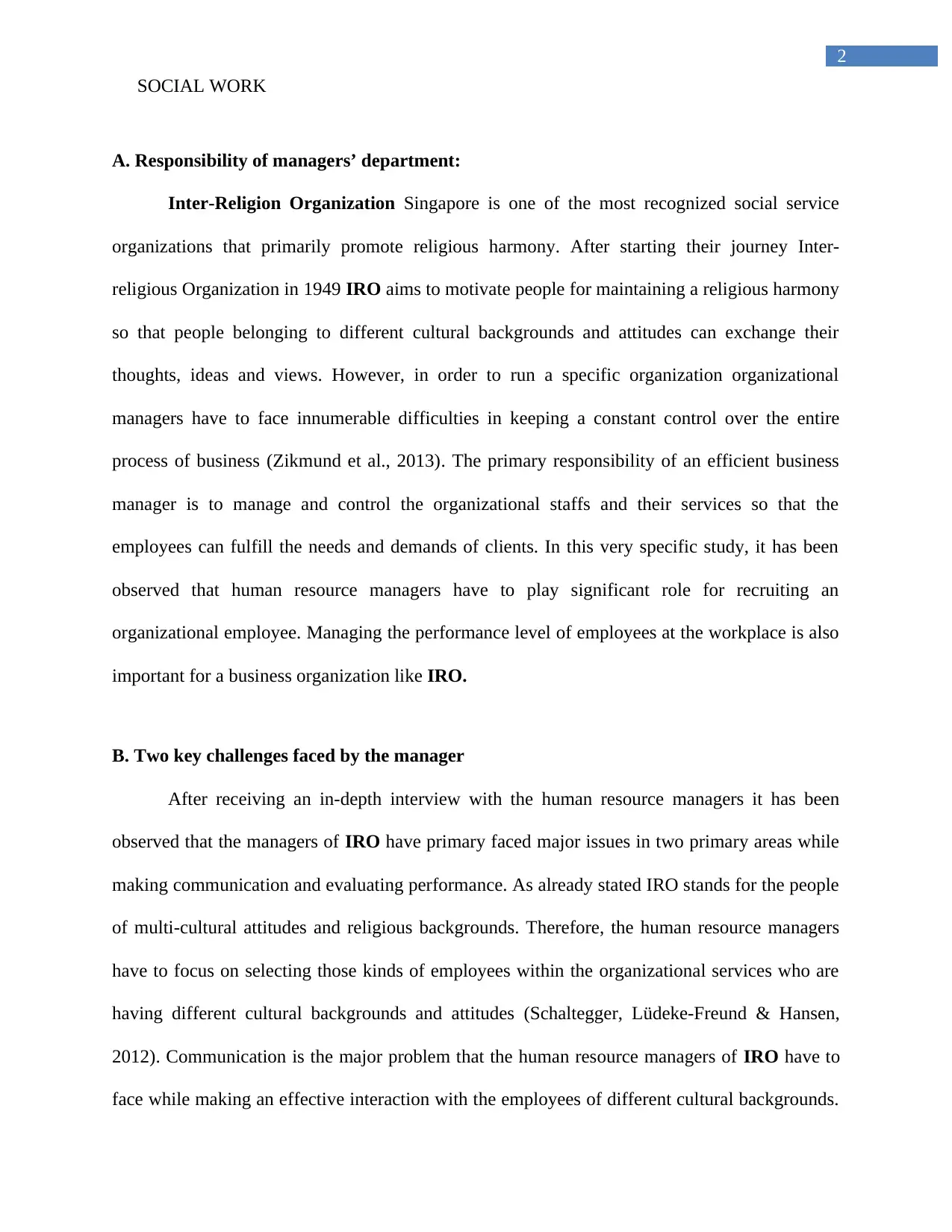
2
SOCIAL WORK
A. Responsibility of managers’ department:
Inter-Religion Organization Singapore is one of the most recognized social service
organizations that primarily promote religious harmony. After starting their journey Inter-
religious Organization in 1949 IRO aims to motivate people for maintaining a religious harmony
so that people belonging to different cultural backgrounds and attitudes can exchange their
thoughts, ideas and views. However, in order to run a specific organization organizational
managers have to face innumerable difficulties in keeping a constant control over the entire
process of business (Zikmund et al., 2013). The primary responsibility of an efficient business
manager is to manage and control the organizational staffs and their services so that the
employees can fulfill the needs and demands of clients. In this very specific study, it has been
observed that human resource managers have to play significant role for recruiting an
organizational employee. Managing the performance level of employees at the workplace is also
important for a business organization like IRO.
B. Two key challenges faced by the manager
After receiving an in-depth interview with the human resource managers it has been
observed that the managers of IRO have primary faced major issues in two primary areas while
making communication and evaluating performance. As already stated IRO stands for the people
of multi-cultural attitudes and religious backgrounds. Therefore, the human resource managers
have to focus on selecting those kinds of employees within the organizational services who are
having different cultural backgrounds and attitudes (Schaltegger, Lüdeke-Freund & Hansen,
2012). Communication is the major problem that the human resource managers of IRO have to
face while making an effective interaction with the employees of different cultural backgrounds.
SOCIAL WORK
A. Responsibility of managers’ department:
Inter-Religion Organization Singapore is one of the most recognized social service
organizations that primarily promote religious harmony. After starting their journey Inter-
religious Organization in 1949 IRO aims to motivate people for maintaining a religious harmony
so that people belonging to different cultural backgrounds and attitudes can exchange their
thoughts, ideas and views. However, in order to run a specific organization organizational
managers have to face innumerable difficulties in keeping a constant control over the entire
process of business (Zikmund et al., 2013). The primary responsibility of an efficient business
manager is to manage and control the organizational staffs and their services so that the
employees can fulfill the needs and demands of clients. In this very specific study, it has been
observed that human resource managers have to play significant role for recruiting an
organizational employee. Managing the performance level of employees at the workplace is also
important for a business organization like IRO.
B. Two key challenges faced by the manager
After receiving an in-depth interview with the human resource managers it has been
observed that the managers of IRO have primary faced major issues in two primary areas while
making communication and evaluating performance. As already stated IRO stands for the people
of multi-cultural attitudes and religious backgrounds. Therefore, the human resource managers
have to focus on selecting those kinds of employees within the organizational services who are
having different cultural backgrounds and attitudes (Schaltegger, Lüdeke-Freund & Hansen,
2012). Communication is the major problem that the human resource managers of IRO have to
face while making an effective interaction with the employees of different cultural backgrounds.
⊘ This is a preview!⊘
Do you want full access?
Subscribe today to unlock all pages.

Trusted by 1+ million students worldwide
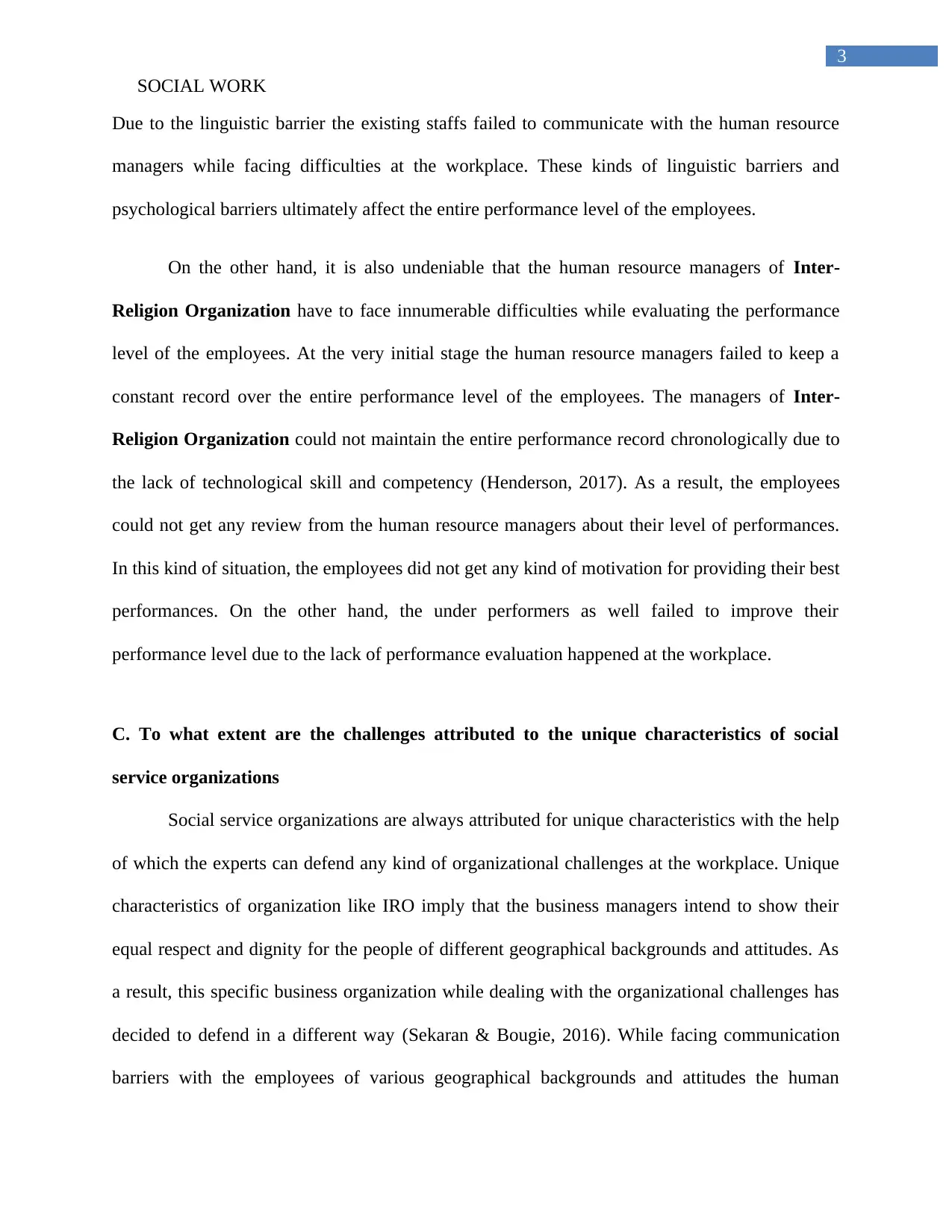
3
SOCIAL WORK
Due to the linguistic barrier the existing staffs failed to communicate with the human resource
managers while facing difficulties at the workplace. These kinds of linguistic barriers and
psychological barriers ultimately affect the entire performance level of the employees.
On the other hand, it is also undeniable that the human resource managers of Inter-
Religion Organization have to face innumerable difficulties while evaluating the performance
level of the employees. At the very initial stage the human resource managers failed to keep a
constant record over the entire performance level of the employees. The managers of Inter-
Religion Organization could not maintain the entire performance record chronologically due to
the lack of technological skill and competency (Henderson, 2017). As a result, the employees
could not get any review from the human resource managers about their level of performances.
In this kind of situation, the employees did not get any kind of motivation for providing their best
performances. On the other hand, the under performers as well failed to improve their
performance level due to the lack of performance evaluation happened at the workplace.
C. To what extent are the challenges attributed to the unique characteristics of social
service organizations
Social service organizations are always attributed for unique characteristics with the help
of which the experts can defend any kind of organizational challenges at the workplace. Unique
characteristics of organization like IRO imply that the business managers intend to show their
equal respect and dignity for the people of different geographical backgrounds and attitudes. As
a result, this specific business organization while dealing with the organizational challenges has
decided to defend in a different way (Sekaran & Bougie, 2016). While facing communication
barriers with the employees of various geographical backgrounds and attitudes the human
SOCIAL WORK
Due to the linguistic barrier the existing staffs failed to communicate with the human resource
managers while facing difficulties at the workplace. These kinds of linguistic barriers and
psychological barriers ultimately affect the entire performance level of the employees.
On the other hand, it is also undeniable that the human resource managers of Inter-
Religion Organization have to face innumerable difficulties while evaluating the performance
level of the employees. At the very initial stage the human resource managers failed to keep a
constant record over the entire performance level of the employees. The managers of Inter-
Religion Organization could not maintain the entire performance record chronologically due to
the lack of technological skill and competency (Henderson, 2017). As a result, the employees
could not get any review from the human resource managers about their level of performances.
In this kind of situation, the employees did not get any kind of motivation for providing their best
performances. On the other hand, the under performers as well failed to improve their
performance level due to the lack of performance evaluation happened at the workplace.
C. To what extent are the challenges attributed to the unique characteristics of social
service organizations
Social service organizations are always attributed for unique characteristics with the help
of which the experts can defend any kind of organizational challenges at the workplace. Unique
characteristics of organization like IRO imply that the business managers intend to show their
equal respect and dignity for the people of different geographical backgrounds and attitudes. As
a result, this specific business organization while dealing with the organizational challenges has
decided to defend in a different way (Sekaran & Bougie, 2016). While facing communication
barriers with the employees of various geographical backgrounds and attitudes the human
Paraphrase This Document
Need a fresh take? Get an instant paraphrase of this document with our AI Paraphraser
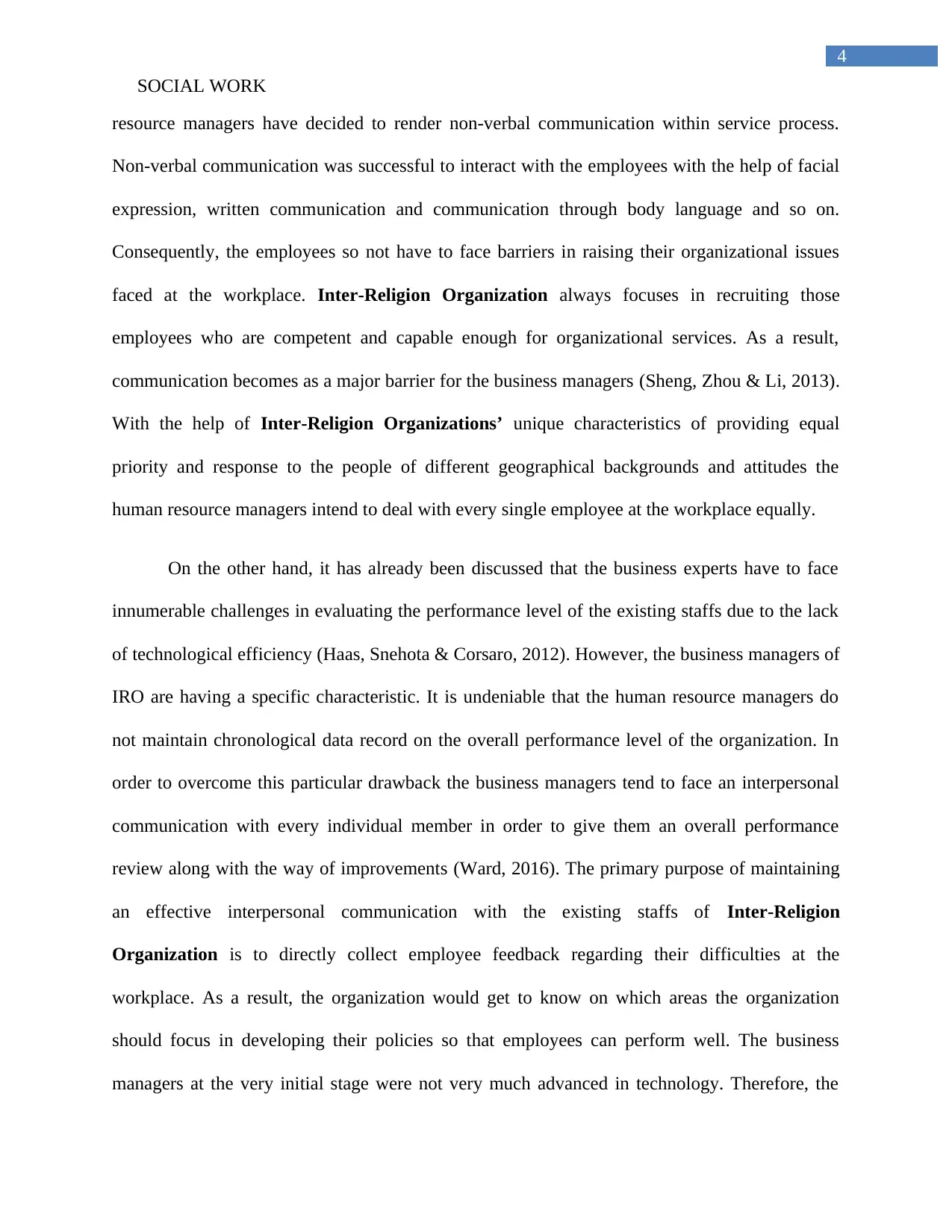
4
SOCIAL WORK
resource managers have decided to render non-verbal communication within service process.
Non-verbal communication was successful to interact with the employees with the help of facial
expression, written communication and communication through body language and so on.
Consequently, the employees so not have to face barriers in raising their organizational issues
faced at the workplace. Inter-Religion Organization always focuses in recruiting those
employees who are competent and capable enough for organizational services. As a result,
communication becomes as a major barrier for the business managers (Sheng, Zhou & Li, 2013).
With the help of Inter-Religion Organizations’ unique characteristics of providing equal
priority and response to the people of different geographical backgrounds and attitudes the
human resource managers intend to deal with every single employee at the workplace equally.
On the other hand, it has already been discussed that the business experts have to face
innumerable challenges in evaluating the performance level of the existing staffs due to the lack
of technological efficiency (Haas, Snehota & Corsaro, 2012). However, the business managers of
IRO are having a specific characteristic. It is undeniable that the human resource managers do
not maintain chronological data record on the overall performance level of the organization. In
order to overcome this particular drawback the business managers tend to face an interpersonal
communication with every individual member in order to give them an overall performance
review along with the way of improvements (Ward, 2016). The primary purpose of maintaining
an effective interpersonal communication with the existing staffs of Inter-Religion
Organization is to directly collect employee feedback regarding their difficulties at the
workplace. As a result, the organization would get to know on which areas the organization
should focus in developing their policies so that employees can perform well. The business
managers at the very initial stage were not very much advanced in technology. Therefore, the
SOCIAL WORK
resource managers have decided to render non-verbal communication within service process.
Non-verbal communication was successful to interact with the employees with the help of facial
expression, written communication and communication through body language and so on.
Consequently, the employees so not have to face barriers in raising their organizational issues
faced at the workplace. Inter-Religion Organization always focuses in recruiting those
employees who are competent and capable enough for organizational services. As a result,
communication becomes as a major barrier for the business managers (Sheng, Zhou & Li, 2013).
With the help of Inter-Religion Organizations’ unique characteristics of providing equal
priority and response to the people of different geographical backgrounds and attitudes the
human resource managers intend to deal with every single employee at the workplace equally.
On the other hand, it has already been discussed that the business experts have to face
innumerable challenges in evaluating the performance level of the existing staffs due to the lack
of technological efficiency (Haas, Snehota & Corsaro, 2012). However, the business managers of
IRO are having a specific characteristic. It is undeniable that the human resource managers do
not maintain chronological data record on the overall performance level of the organization. In
order to overcome this particular drawback the business managers tend to face an interpersonal
communication with every individual member in order to give them an overall performance
review along with the way of improvements (Ward, 2016). The primary purpose of maintaining
an effective interpersonal communication with the existing staffs of Inter-Religion
Organization is to directly collect employee feedback regarding their difficulties at the
workplace. As a result, the organization would get to know on which areas the organization
should focus in developing their policies so that employees can perform well. The business
managers at the very initial stage were not very much advanced in technology. Therefore, the
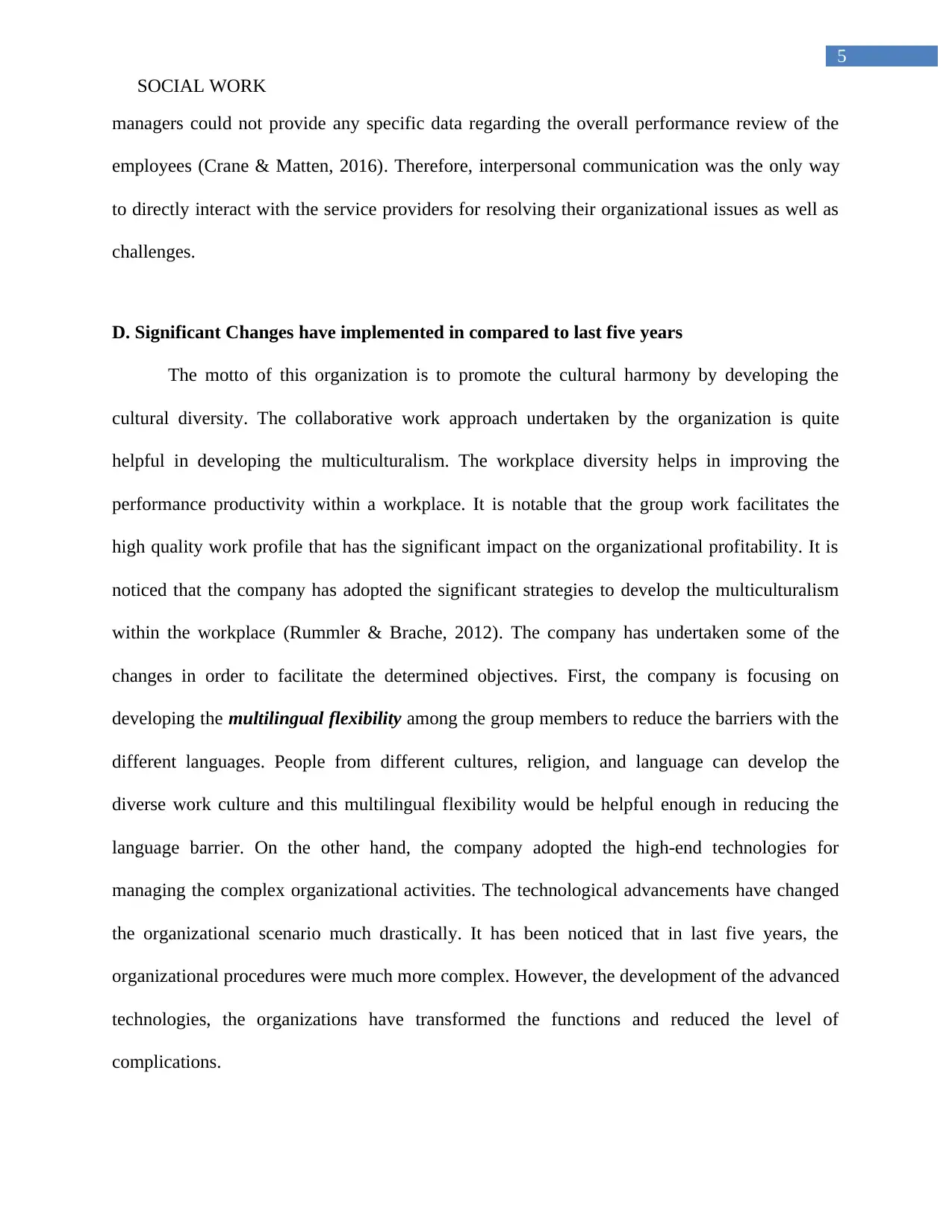
5
SOCIAL WORK
managers could not provide any specific data regarding the overall performance review of the
employees (Crane & Matten, 2016). Therefore, interpersonal communication was the only way
to directly interact with the service providers for resolving their organizational issues as well as
challenges.
D. Significant Changes have implemented in compared to last five years
The motto of this organization is to promote the cultural harmony by developing the
cultural diversity. The collaborative work approach undertaken by the organization is quite
helpful in developing the multiculturalism. The workplace diversity helps in improving the
performance productivity within a workplace. It is notable that the group work facilitates the
high quality work profile that has the significant impact on the organizational profitability. It is
noticed that the company has adopted the significant strategies to develop the multiculturalism
within the workplace (Rummler & Brache, 2012). The company has undertaken some of the
changes in order to facilitate the determined objectives. First, the company is focusing on
developing the multilingual flexibility among the group members to reduce the barriers with the
different languages. People from different cultures, religion, and language can develop the
diverse work culture and this multilingual flexibility would be helpful enough in reducing the
language barrier. On the other hand, the company adopted the high-end technologies for
managing the complex organizational activities. The technological advancements have changed
the organizational scenario much drastically. It has been noticed that in last five years, the
organizational procedures were much more complex. However, the development of the advanced
technologies, the organizations have transformed the functions and reduced the level of
complications.
SOCIAL WORK
managers could not provide any specific data regarding the overall performance review of the
employees (Crane & Matten, 2016). Therefore, interpersonal communication was the only way
to directly interact with the service providers for resolving their organizational issues as well as
challenges.
D. Significant Changes have implemented in compared to last five years
The motto of this organization is to promote the cultural harmony by developing the
cultural diversity. The collaborative work approach undertaken by the organization is quite
helpful in developing the multiculturalism. The workplace diversity helps in improving the
performance productivity within a workplace. It is notable that the group work facilitates the
high quality work profile that has the significant impact on the organizational profitability. It is
noticed that the company has adopted the significant strategies to develop the multiculturalism
within the workplace (Rummler & Brache, 2012). The company has undertaken some of the
changes in order to facilitate the determined objectives. First, the company is focusing on
developing the multilingual flexibility among the group members to reduce the barriers with the
different languages. People from different cultures, religion, and language can develop the
diverse work culture and this multilingual flexibility would be helpful enough in reducing the
language barrier. On the other hand, the company adopted the high-end technologies for
managing the complex organizational activities. The technological advancements have changed
the organizational scenario much drastically. It has been noticed that in last five years, the
organizational procedures were much more complex. However, the development of the advanced
technologies, the organizations have transformed the functions and reduced the level of
complications.
⊘ This is a preview!⊘
Do you want full access?
Subscribe today to unlock all pages.

Trusted by 1+ million students worldwide

6
SOCIAL WORK
E. Effects of Changes on the organizational external and internal environment
The changes brought to the organizational scenario have the clear impact both internally
and externally. The multiculturalism and the development of the Multilanguage Flexibility
within the organization are quite beneficial for sustaining the competitive position for a longer
time. It is notable that the working with the group of people from different cultures and
languages helps in building the diversified works, which are quite innovative in nature. The
alignment of people from different cultures improves the organizational functions. On the other
hand, the development of thee high-end technologies has been improving the work procedures
and culture (Epstein & Buhovac, 2014). The efficiency maintained in the internal organization
results in the improvements of external environment as well. The upgraded technologies have
been reducing the time and efforts and providing the productive results. The customers in the
external market are thus receiving the high quality products and services. However, one of the
major determinants found in the external market is the changes in the customer demands. The
level of competition is growing higher and the organization strives to meet the perceived
expectations of the potential customers.
The increasing level of competition is demanding for the high improved technicalities
and unique value added services. In such cases, it is notable that the maintenance of the customer
demands would secure the competitive edge (Hammer, 2015). Moreover, the supports derived
from the political figures are also necessary for the sustainable position of the organization. The
multiculturalism might have created the significant impact on the organizational activities.
However, mismanagement of the culture related barriers could create more obligations in
developing the secure future in the external competitive market. Hence, it can be implied that
SOCIAL WORK
E. Effects of Changes on the organizational external and internal environment
The changes brought to the organizational scenario have the clear impact both internally
and externally. The multiculturalism and the development of the Multilanguage Flexibility
within the organization are quite beneficial for sustaining the competitive position for a longer
time. It is notable that the working with the group of people from different cultures and
languages helps in building the diversified works, which are quite innovative in nature. The
alignment of people from different cultures improves the organizational functions. On the other
hand, the development of thee high-end technologies has been improving the work procedures
and culture (Epstein & Buhovac, 2014). The efficiency maintained in the internal organization
results in the improvements of external environment as well. The upgraded technologies have
been reducing the time and efforts and providing the productive results. The customers in the
external market are thus receiving the high quality products and services. However, one of the
major determinants found in the external market is the changes in the customer demands. The
level of competition is growing higher and the organization strives to meet the perceived
expectations of the potential customers.
The increasing level of competition is demanding for the high improved technicalities
and unique value added services. In such cases, it is notable that the maintenance of the customer
demands would secure the competitive edge (Hammer, 2015). Moreover, the supports derived
from the political figures are also necessary for the sustainable position of the organization. The
multiculturalism might have created the significant impact on the organizational activities.
However, mismanagement of the culture related barriers could create more obligations in
developing the secure future in the external competitive market. Hence, it can be implied that
Paraphrase This Document
Need a fresh take? Get an instant paraphrase of this document with our AI Paraphraser
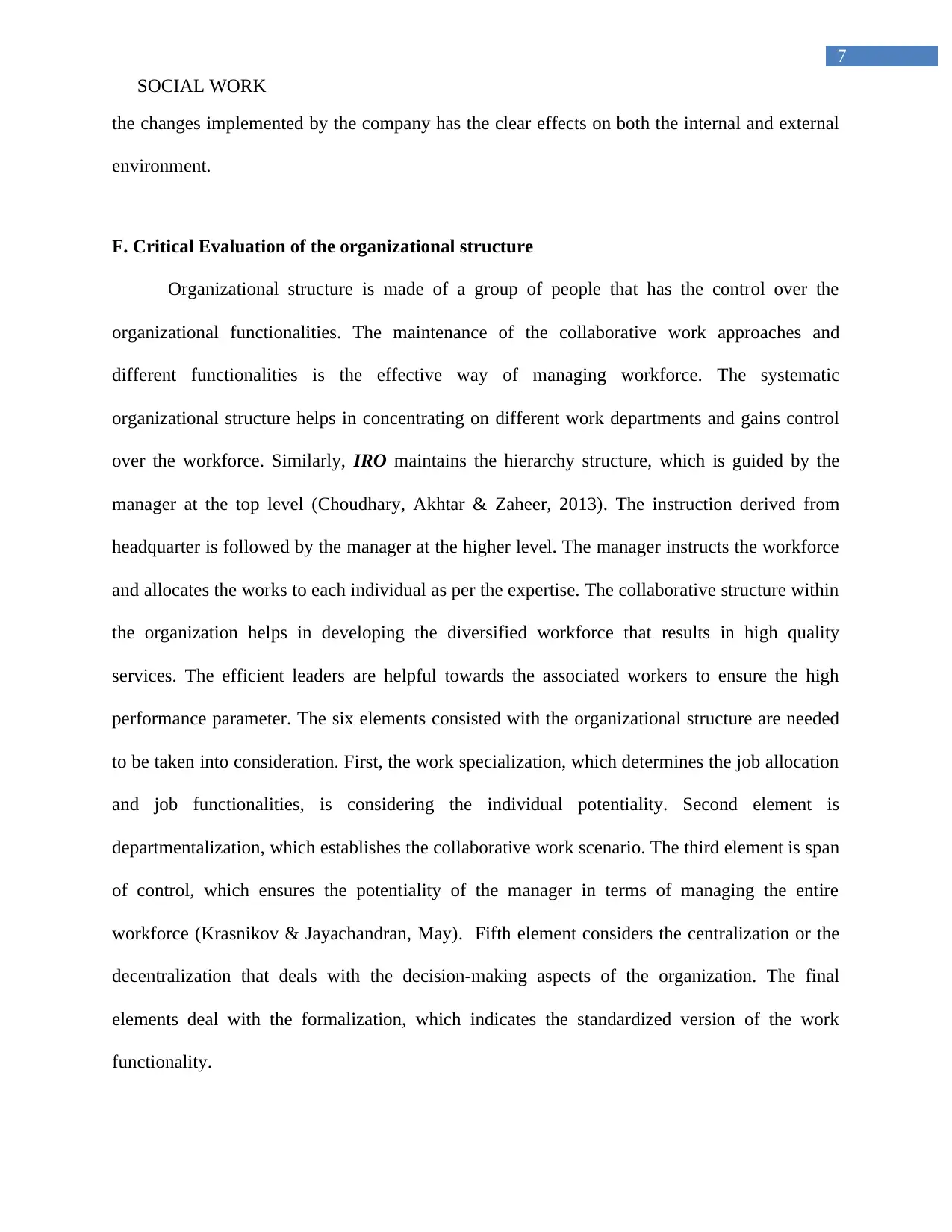
7
SOCIAL WORK
the changes implemented by the company has the clear effects on both the internal and external
environment.
F. Critical Evaluation of the organizational structure
Organizational structure is made of a group of people that has the control over the
organizational functionalities. The maintenance of the collaborative work approaches and
different functionalities is the effective way of managing workforce. The systematic
organizational structure helps in concentrating on different work departments and gains control
over the workforce. Similarly, IRO maintains the hierarchy structure, which is guided by the
manager at the top level (Choudhary, Akhtar & Zaheer, 2013). The instruction derived from
headquarter is followed by the manager at the higher level. The manager instructs the workforce
and allocates the works to each individual as per the expertise. The collaborative structure within
the organization helps in developing the diversified workforce that results in high quality
services. The efficient leaders are helpful towards the associated workers to ensure the high
performance parameter. The six elements consisted with the organizational structure are needed
to be taken into consideration. First, the work specialization, which determines the job allocation
and job functionalities, is considering the individual potentiality. Second element is
departmentalization, which establishes the collaborative work scenario. The third element is span
of control, which ensures the potentiality of the manager in terms of managing the entire
workforce (Krasnikov & Jayachandran, May). Fifth element considers the centralization or the
decentralization that deals with the decision-making aspects of the organization. The final
elements deal with the formalization, which indicates the standardized version of the work
functionality.
SOCIAL WORK
the changes implemented by the company has the clear effects on both the internal and external
environment.
F. Critical Evaluation of the organizational structure
Organizational structure is made of a group of people that has the control over the
organizational functionalities. The maintenance of the collaborative work approaches and
different functionalities is the effective way of managing workforce. The systematic
organizational structure helps in concentrating on different work departments and gains control
over the workforce. Similarly, IRO maintains the hierarchy structure, which is guided by the
manager at the top level (Choudhary, Akhtar & Zaheer, 2013). The instruction derived from
headquarter is followed by the manager at the higher level. The manager instructs the workforce
and allocates the works to each individual as per the expertise. The collaborative structure within
the organization helps in developing the diversified workforce that results in high quality
services. The efficient leaders are helpful towards the associated workers to ensure the high
performance parameter. The six elements consisted with the organizational structure are needed
to be taken into consideration. First, the work specialization, which determines the job allocation
and job functionalities, is considering the individual potentiality. Second element is
departmentalization, which establishes the collaborative work scenario. The third element is span
of control, which ensures the potentiality of the manager in terms of managing the entire
workforce (Krasnikov & Jayachandran, May). Fifth element considers the centralization or the
decentralization that deals with the decision-making aspects of the organization. The final
elements deal with the formalization, which indicates the standardized version of the work
functionality.
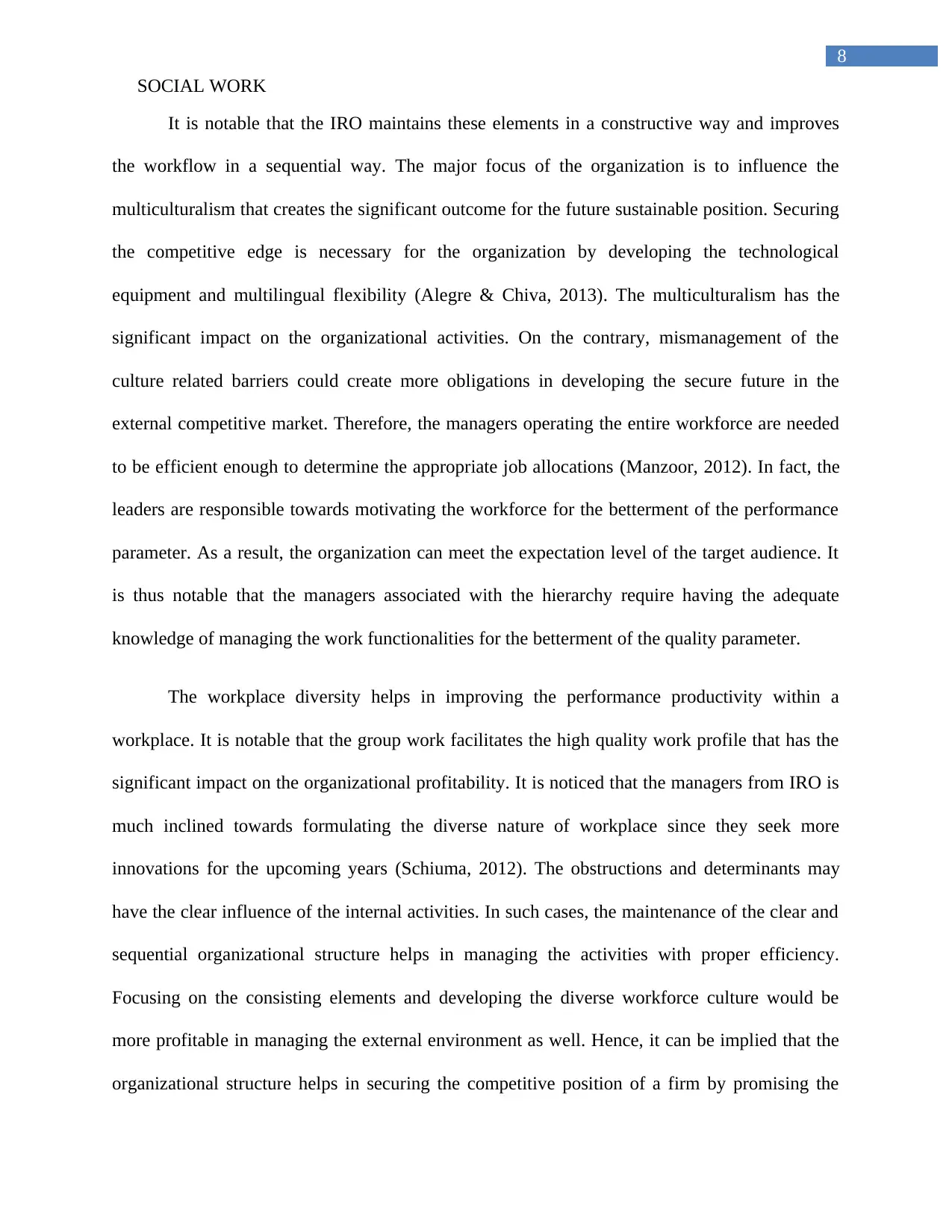
8
SOCIAL WORK
It is notable that the IRO maintains these elements in a constructive way and improves
the workflow in a sequential way. The major focus of the organization is to influence the
multiculturalism that creates the significant outcome for the future sustainable position. Securing
the competitive edge is necessary for the organization by developing the technological
equipment and multilingual flexibility (Alegre & Chiva, 2013). The multiculturalism has the
significant impact on the organizational activities. On the contrary, mismanagement of the
culture related barriers could create more obligations in developing the secure future in the
external competitive market. Therefore, the managers operating the entire workforce are needed
to be efficient enough to determine the appropriate job allocations (Manzoor, 2012). In fact, the
leaders are responsible towards motivating the workforce for the betterment of the performance
parameter. As a result, the organization can meet the expectation level of the target audience. It
is thus notable that the managers associated with the hierarchy require having the adequate
knowledge of managing the work functionalities for the betterment of the quality parameter.
The workplace diversity helps in improving the performance productivity within a
workplace. It is notable that the group work facilitates the high quality work profile that has the
significant impact on the organizational profitability. It is noticed that the managers from IRO is
much inclined towards formulating the diverse nature of workplace since they seek more
innovations for the upcoming years (Schiuma, 2012). The obstructions and determinants may
have the clear influence of the internal activities. In such cases, the maintenance of the clear and
sequential organizational structure helps in managing the activities with proper efficiency.
Focusing on the consisting elements and developing the diverse workforce culture would be
more profitable in managing the external environment as well. Hence, it can be implied that the
organizational structure helps in securing the competitive position of a firm by promising the
SOCIAL WORK
It is notable that the IRO maintains these elements in a constructive way and improves
the workflow in a sequential way. The major focus of the organization is to influence the
multiculturalism that creates the significant outcome for the future sustainable position. Securing
the competitive edge is necessary for the organization by developing the technological
equipment and multilingual flexibility (Alegre & Chiva, 2013). The multiculturalism has the
significant impact on the organizational activities. On the contrary, mismanagement of the
culture related barriers could create more obligations in developing the secure future in the
external competitive market. Therefore, the managers operating the entire workforce are needed
to be efficient enough to determine the appropriate job allocations (Manzoor, 2012). In fact, the
leaders are responsible towards motivating the workforce for the betterment of the performance
parameter. As a result, the organization can meet the expectation level of the target audience. It
is thus notable that the managers associated with the hierarchy require having the adequate
knowledge of managing the work functionalities for the betterment of the quality parameter.
The workplace diversity helps in improving the performance productivity within a
workplace. It is notable that the group work facilitates the high quality work profile that has the
significant impact on the organizational profitability. It is noticed that the managers from IRO is
much inclined towards formulating the diverse nature of workplace since they seek more
innovations for the upcoming years (Schiuma, 2012). The obstructions and determinants may
have the clear influence of the internal activities. In such cases, the maintenance of the clear and
sequential organizational structure helps in managing the activities with proper efficiency.
Focusing on the consisting elements and developing the diverse workforce culture would be
more profitable in managing the external environment as well. Hence, it can be implied that the
organizational structure helps in securing the competitive position of a firm by promising the
⊘ This is a preview!⊘
Do you want full access?
Subscribe today to unlock all pages.

Trusted by 1+ million students worldwide

9
SOCIAL WORK
better work approaches. However, the enough motivations from the leaders and efficiency
maintained in the work culture would be more beneficial and remarkable.
SOCIAL WORK
better work approaches. However, the enough motivations from the leaders and efficiency
maintained in the work culture would be more beneficial and remarkable.
Paraphrase This Document
Need a fresh take? Get an instant paraphrase of this document with our AI Paraphraser
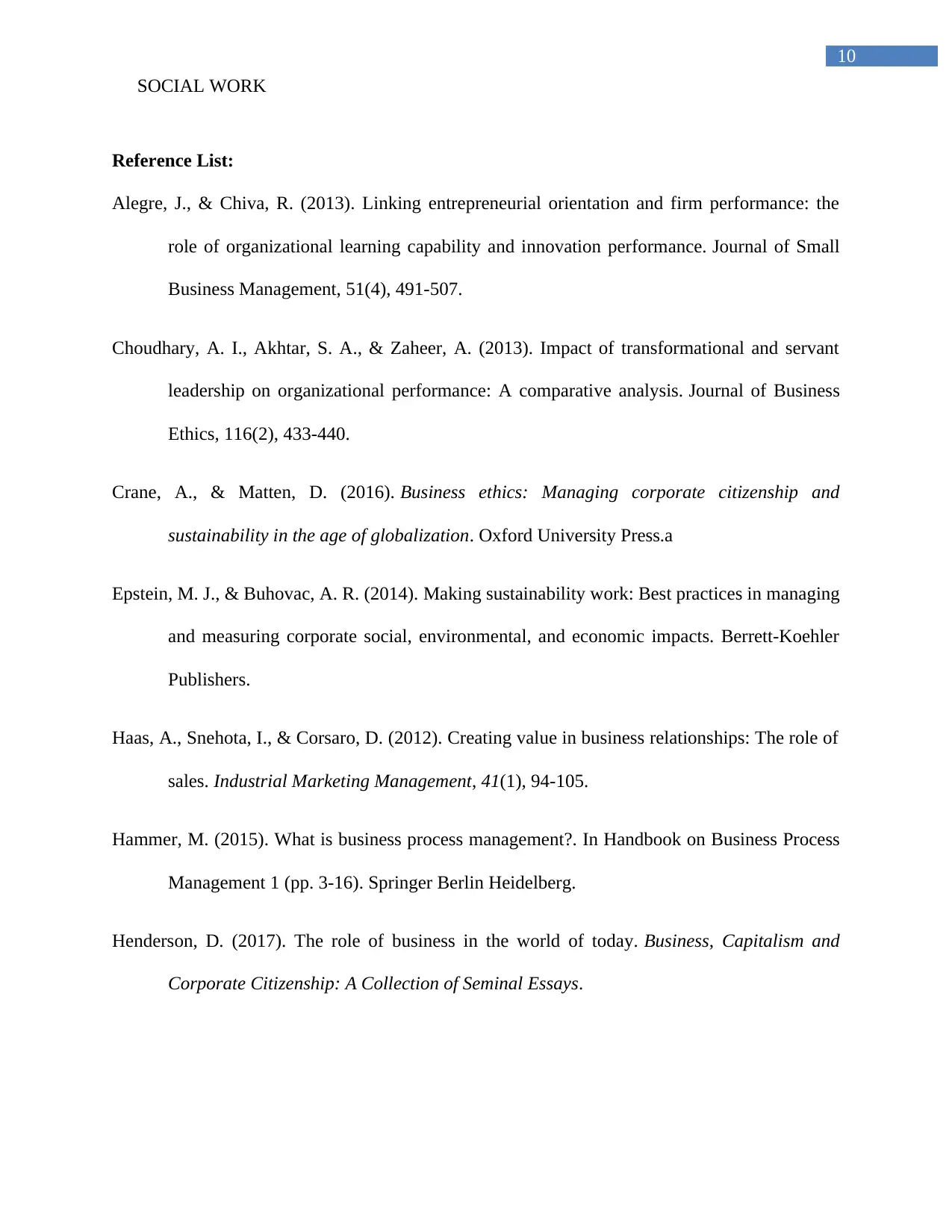
10
SOCIAL WORK
Reference List:
Alegre, J., & Chiva, R. (2013). Linking entrepreneurial orientation and firm performance: the
role of organizational learning capability and innovation performance. Journal of Small
Business Management, 51(4), 491-507.
Choudhary, A. I., Akhtar, S. A., & Zaheer, A. (2013). Impact of transformational and servant
leadership on organizational performance: A comparative analysis. Journal of Business
Ethics, 116(2), 433-440.
Crane, A., & Matten, D. (2016). Business ethics: Managing corporate citizenship and
sustainability in the age of globalization. Oxford University Press.a
Epstein, M. J., & Buhovac, A. R. (2014). Making sustainability work: Best practices in managing
and measuring corporate social, environmental, and economic impacts. Berrett-Koehler
Publishers.
Haas, A., Snehota, I., & Corsaro, D. (2012). Creating value in business relationships: The role of
sales. Industrial Marketing Management, 41(1), 94-105.
Hammer, M. (2015). What is business process management?. In Handbook on Business Process
Management 1 (pp. 3-16). Springer Berlin Heidelberg.
Henderson, D. (2017). The role of business in the world of today. Business, Capitalism and
Corporate Citizenship: A Collection of Seminal Essays.
SOCIAL WORK
Reference List:
Alegre, J., & Chiva, R. (2013). Linking entrepreneurial orientation and firm performance: the
role of organizational learning capability and innovation performance. Journal of Small
Business Management, 51(4), 491-507.
Choudhary, A. I., Akhtar, S. A., & Zaheer, A. (2013). Impact of transformational and servant
leadership on organizational performance: A comparative analysis. Journal of Business
Ethics, 116(2), 433-440.
Crane, A., & Matten, D. (2016). Business ethics: Managing corporate citizenship and
sustainability in the age of globalization. Oxford University Press.a
Epstein, M. J., & Buhovac, A. R. (2014). Making sustainability work: Best practices in managing
and measuring corporate social, environmental, and economic impacts. Berrett-Koehler
Publishers.
Haas, A., Snehota, I., & Corsaro, D. (2012). Creating value in business relationships: The role of
sales. Industrial Marketing Management, 41(1), 94-105.
Hammer, M. (2015). What is business process management?. In Handbook on Business Process
Management 1 (pp. 3-16). Springer Berlin Heidelberg.
Henderson, D. (2017). The role of business in the world of today. Business, Capitalism and
Corporate Citizenship: A Collection of Seminal Essays.
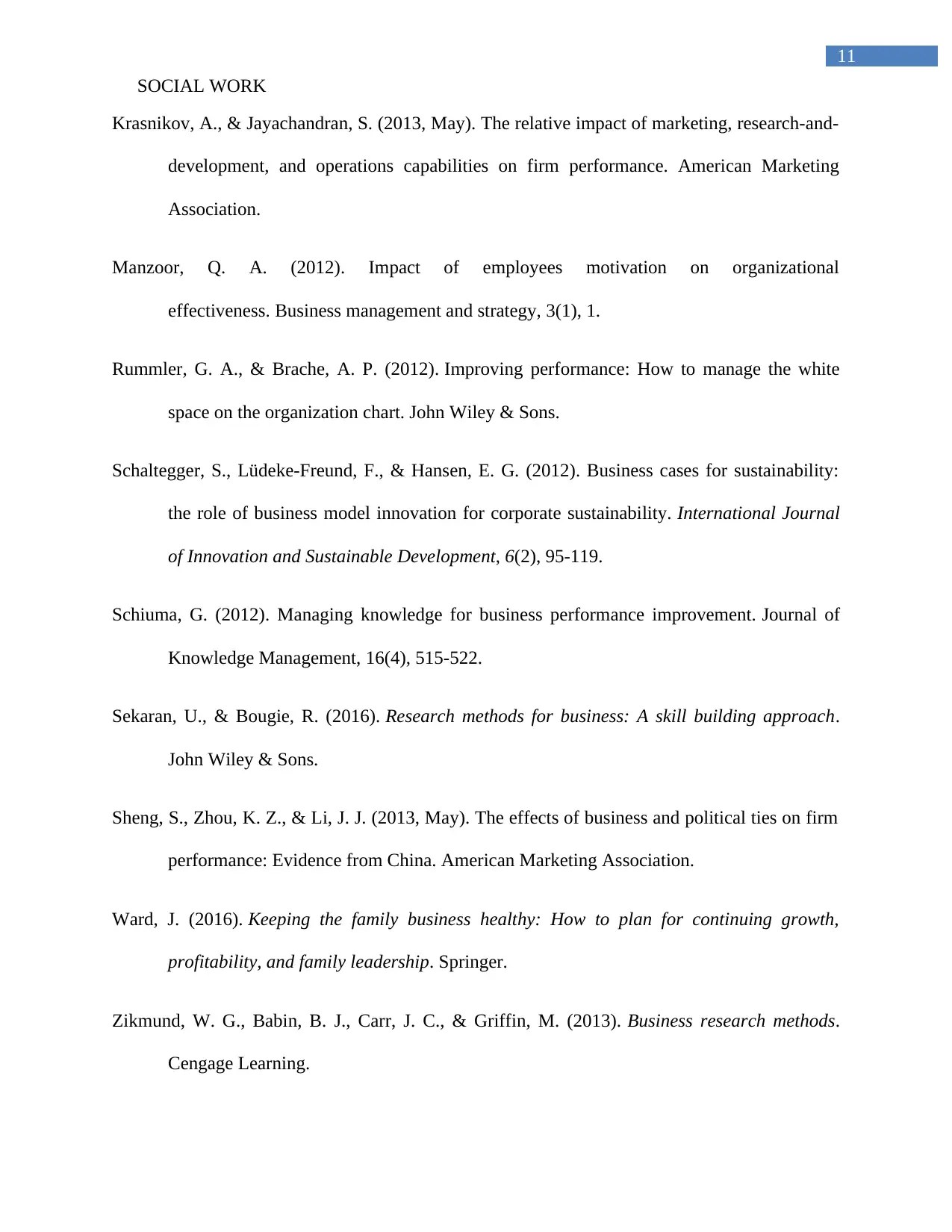
11
SOCIAL WORK
Krasnikov, A., & Jayachandran, S. (2013, May). The relative impact of marketing, research-and-
development, and operations capabilities on firm performance. American Marketing
Association.
Manzoor, Q. A. (2012). Impact of employees motivation on organizational
effectiveness. Business management and strategy, 3(1), 1.
Rummler, G. A., & Brache, A. P. (2012). Improving performance: How to manage the white
space on the organization chart. John Wiley & Sons.
Schaltegger, S., Lüdeke-Freund, F., & Hansen, E. G. (2012). Business cases for sustainability:
the role of business model innovation for corporate sustainability. International Journal
of Innovation and Sustainable Development, 6(2), 95-119.
Schiuma, G. (2012). Managing knowledge for business performance improvement. Journal of
Knowledge Management, 16(4), 515-522.
Sekaran, U., & Bougie, R. (2016). Research methods for business: A skill building approach.
John Wiley & Sons.
Sheng, S., Zhou, K. Z., & Li, J. J. (2013, May). The effects of business and political ties on firm
performance: Evidence from China. American Marketing Association.
Ward, J. (2016). Keeping the family business healthy: How to plan for continuing growth,
profitability, and family leadership. Springer.
Zikmund, W. G., Babin, B. J., Carr, J. C., & Griffin, M. (2013). Business research methods.
Cengage Learning.
SOCIAL WORK
Krasnikov, A., & Jayachandran, S. (2013, May). The relative impact of marketing, research-and-
development, and operations capabilities on firm performance. American Marketing
Association.
Manzoor, Q. A. (2012). Impact of employees motivation on organizational
effectiveness. Business management and strategy, 3(1), 1.
Rummler, G. A., & Brache, A. P. (2012). Improving performance: How to manage the white
space on the organization chart. John Wiley & Sons.
Schaltegger, S., Lüdeke-Freund, F., & Hansen, E. G. (2012). Business cases for sustainability:
the role of business model innovation for corporate sustainability. International Journal
of Innovation and Sustainable Development, 6(2), 95-119.
Schiuma, G. (2012). Managing knowledge for business performance improvement. Journal of
Knowledge Management, 16(4), 515-522.
Sekaran, U., & Bougie, R. (2016). Research methods for business: A skill building approach.
John Wiley & Sons.
Sheng, S., Zhou, K. Z., & Li, J. J. (2013, May). The effects of business and political ties on firm
performance: Evidence from China. American Marketing Association.
Ward, J. (2016). Keeping the family business healthy: How to plan for continuing growth,
profitability, and family leadership. Springer.
Zikmund, W. G., Babin, B. J., Carr, J. C., & Griffin, M. (2013). Business research methods.
Cengage Learning.
⊘ This is a preview!⊘
Do you want full access?
Subscribe today to unlock all pages.

Trusted by 1+ million students worldwide
1 out of 13
Related Documents
Your All-in-One AI-Powered Toolkit for Academic Success.
+13062052269
info@desklib.com
Available 24*7 on WhatsApp / Email
![[object Object]](/_next/static/media/star-bottom.7253800d.svg)
Unlock your academic potential
Copyright © 2020–2025 A2Z Services. All Rights Reserved. Developed and managed by ZUCOL.





